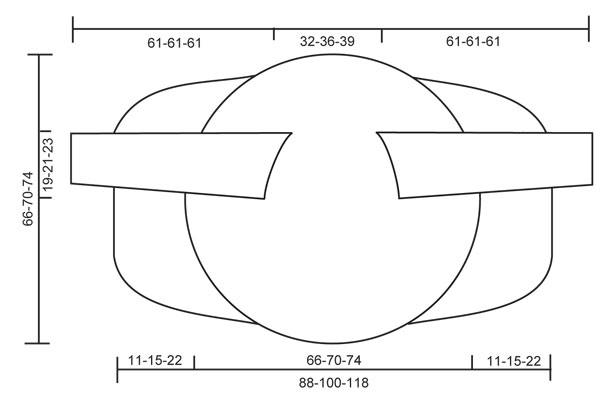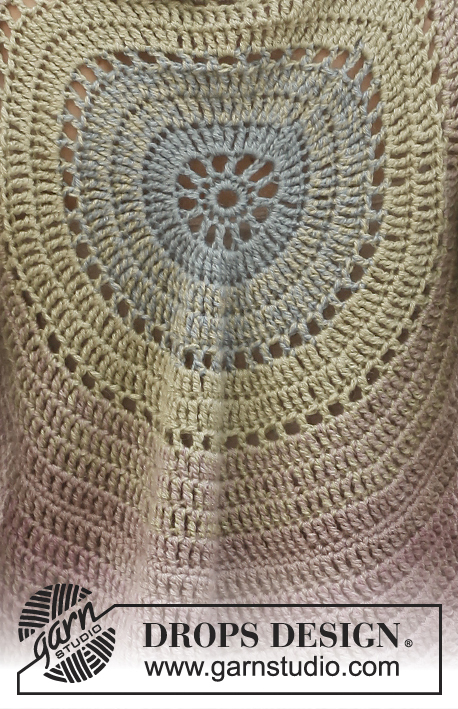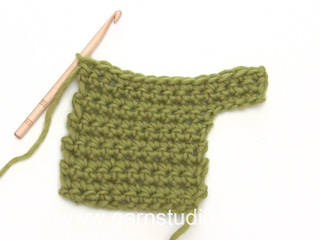Summer Circle |
|
 |
 |
Crochet DROPS jacket worked in a circle in 2 threads ”BabyAlpaca Silk”. Size: S - XXXL.
DROPS 136-1 |
|
|
STRIPES: BODY: Beg with 2 threads light sea green. Then work 3-3-4 rounds with each of the following colours: Stripe 1: 2 threads light sea green, Stripe 2: 1 thread light sea green and 1 thread pistachio Stripe 3: 2 threads pistachio Stripe 4: 1 thread pistachio and 1 thread light grey purple Stripe 5: 2 threads light grey purple, Stripe 6: 1 thread light old pink and 1 thread light grey purple Stripe 7: 2 threads light old pink, Stripe 8: 1 thread light old pink and 1 thread grey purple Stripe 9 until finished measurements: 2 threads grey purple SLEEVE: Worked in stripes. Work sleeve cap as 5th-5th-4th stripe, then work 12 cm as stripe 4-4-3, 12 cm as stripe 3-3-2, 12 cm as stripe 2-2-1, and work as stripe 1 until finished measurements. CROCHET TIP: Replace first dtr on every round/row with 4 ch. DECREASE TIP 1 (applies to the body): Dec as follows: Work dtr until 3 dtr remain, * in the first of these work 1 tr, in the next 1 htr and in the last 1 dc, turn with 1 ch, skip dc, work 1 sl st in htr and 1 sl st in tr, then 1 dc in first dtr, 1 htr in next dtr and 1 tr in next dtr, work dtr until 3 dtr remain at end of row *, repeat from *-* until a total of 6-8-12 rows have been worked. DECREASE TIP 2 (applies to sleeve): Dec at beg of row by working sl st over the no of dtr to be dec. Dec at end of row by working until same no of dtr to be dec remains, turn piece. -------------------------------------------------------- BODY: Worked in the round in a circle from mid back with 2 threads BabyAlpaca Silk and STRIPES – see explanation above. Crochet 8 ch on hook size 5 mm and form a ring with 1 sl st in first ch. ROUND 1: Work 12 dc in ch-ring, finish with 1 sl st in first dc. ROUND 2: 5 ch (= 1 tr + 2 ch), * 1 tr in next dc, 2 ch *, repeat from *-* the entire round and finish with 1 sl st in 3rd ch from beg of round = 12 tr with 2 ch between each. ROUND 3: READ CROCHET TIP! 1 dtr, 2 dtr in same tr, * 1 dtr in ch-loop, 3 dtr in next tr *, finish with 1 dtr in the last ch-loop and 1 sl st in 4th ch from beg of round = 48 dtr. ROUND 4: 1 dtr, * 2 dtr in next dtr, 1 dtr in next dtr *, repeat from *-* and finish with 2 dtr in next dtr and 1 sl st in 4th ch from beg of round = 72 dtr. ROUND 5: 1 dtr, * 2 dtr in next dtr, 1 dtr in each of the next 2 dtr * repeat from *-* and finish with 2 dtr in next dtr, 1 dtr in next dtr and 1 sl st in 4th ch = 96 dtr. ROUND 6: 5 ch (= 1 tr + 2 ch), * skip 1 dtr, 1 tr in next dtr, 2 ch *, repeat from *-* the entire round and finish with 1 sl st in 3rd ch from beg of round = 48 ch-loops. ROUND 7: Work 1 dtr in every tr and work 1 and 2 dtr alternately in every ch-loop the entire round = 120 dtr. ROUND 8: Work 1 dtr in every dtr but work 2 dtr in every 10th dtr = 132 dtr. ROUND 9: 5 ch (= 1 tr + 2 ch), * skip 1 dtr, 1 tr in next dtr, 2 ch *, repeat from *-* the entire round and finish with 1 sl st in 3rd ch from beg of round = 66 ch-loops. ROUND 10: Work 1 dtr in every tr and work 1 and 2 dtr alternately in every ch-loop the entire round = 165 dtr. ROUND 11: Work 1 dtr in every dtr but work 2 dtr in every 15th dtr = 176 dtr. ROUND 12: Work 1 dtr in every dtr but work 2 dtr in every 16th dtr = 187 dtr. Piece measures approx. 20 cm from centre and outwards. SIZE S/M: ROUND 13: 1 ch, then work 1 dc in each of the first 45 dtr (= up towards neck), work 30 loose ch, skip the next 27 dtr (= armhole), then work 1 dc in each of the next 88 dtr (= down towards back), work 30 loose ch, skip the next 27 dtr (= armhole) and fasten with 1 sl st in first dc on round. ROUND 14: Work 1 dtr in every dc - but inc 2 dtr evenly over the first 45 dc (= 47 dtr), then work 30 dtr in ch-row over armhole, work 1 dtr in every dc – but inc 3 dtr evenly over the bottom 88 dc (= 91 dtr), work 30 dtr in ch-row over armhole and fasten with 1 sl st in 4th ch = 198 dtr. ROUND 15 to 19: Continue with dtr – while at the same time inc 6 dtr evenly on every round. After 19th round there are 228 dtr on the round and piece measures approx. 33 cm from centre and outwards. Continue working only over 79 dtr in each side – i.e. do not work over 35 dtr at top by neck and 35 dtr at bottom of back. Cut the thread. Continue with explanation below front piece. SIZE L/XL: ROUND 13: Work 1 dtr in every dtr but work 2 dtr in every 17th dtr = 198 dtr. ROUND 14: 1 ch, then work 1 dc in each of the first 50 dtr (= up towards neck), work 32 loose ch, skip the next 29 dtr (= armhole), then work 1 dc in each of the next 90 dtr (= down towards back), work 32 loose ch, skip the next 29 dtr (= armhole) and fasten with 1 sl st in first dc on round. ROUND 15: Work 1 dtr in every dc - but inc 3 dtr evenly over the first 50 dc (= 53 dtr), then work 32 dtr in ch-row over armhole, work 1 dtr in every dc – but inc 3 dtr evenly over the bottom 90 dc (= 93 dtr), work 32 dtr in ch-row over armhole and fasten with 1 sl st in 4th ch = 210 dtr. ROUND 16 to 20: Continue with dtr – while at the same time inc 6 dtr evenly on every round. After 20th round there are 240 dtr on the round and piece measures approx. 35 cm from centre and outwards. Continue working only over 81 dtr in each side – i.e. do not work over 39 dtr at top by neck and 39 dtr at bottom of back. Cut the thread. Continue with explanation below front piece. SIZE XXL/XXXL: ROUND 13: Work 1 dtr in every dtr but work 2 dtr in every 17th dtr = 198 dtr. ROUND 14: Work 1 dtr in every dtr but work 2 dtr in every 18th dtr = 209 dtr. ROUND 15: 1 ch, then work 1 dc in each of the first 54 dtr (= up towards neck), work 36 loose ch, skip the next 32 dtr (= armhole), then work 1 dc in each of the next 91 dtr (= down towards back), work 36 loose ch, skip the next 32 dtr (= armhole) and fasten with 1 sl st in first dc on round. ROUND 16: Work 1 dtr in every dc - but inc 2 dtr evenly over the first 54 dc (= 56 dtr), then work 36 dtr in ch-row over armhole, work 1 dtr in every dc – but inc 3 dtr evenly over the bottom 91 dc (= 94 dtr), and work 36 dtr in ch-row over armhole = 222 dtr. ROUND 17 to 22: Continue with dtr – while at the same time inc 6 dtr evenly on every round. After 22nd round there are 258 dtr on the round and piece measures approx. 37 cm from centre and outwards. Continue working only over 89 dtr in each side – i.e. do not work over 40 dtr at top by neck and 40 dtr at bottom of back. Continue with explanation below front piece. LEFT FRONT PIECE - ALL SIZES: = 79-81-89 dtr. Insert a marker after 23-24-27 sts in from each side (= 33-33-35 sts between markers). Then work dtr back and forth over these sts while at the same time inc 1 st at every marker on every row (i.e. inc 2 sts on row, inc alternately before and after marker) and dec 3 sts at end and beg of every row in each side – SEE DECREASE TIP 1 until a total of 6-8-12 rows back and forth have been worked = 55-49-41 dtr. RIGHT FRONT PIECE: Work same way as on left piece over 79-81-89 dtr in right side. SLEEVE: Worked back and forth from sleeve cap and down with 2 threads BabyAlpaca Silk and STRIPES – see explanation above. Work 28-34-38 ch with stripe 5-5-4. Turn and work 1 dtr in 5th ch from hook ( = 2 dtr), then work 1 dtr in every ch = 25-31-35 dtr. ROW 2: Work 4 ch, 3 dtr in first dtr, 1 dtr in each of the next 23-29-33 dtr, 4 dtr in the last dtr = 31-37-41 dtr. Turn. ROW 3, 4 and 5: Work 4 ch, 2 dtr in first dtr, 1 dtr in every dtr until 1 dtr remains, 3 dtr in the last dtr = 43-49-53 dtr. Turn. ROW 6: Work 4 ch, 3 dtr in first dtr, 1 dtr in each of the next 41-47-51 dtr, 4 dtr in the last dtr = 49-55-59 dtr. Turn. Switch to stripe 4-4-3 here. Then work dtr on all rows until piece measures 17-15-15 cm. Continue with dtr while AT THE SAME TIME dec as follows in each side: SIZE S/M: * Work 1 row where dec 1 dtr in each side - see Decrease tip. Work 1 row without dec. Work 1 row where dec 1 dtr in each side. Work 2 rows without dec *, repeat from *-* a total of 3 times = 12 dec = 37 dtr. SIZE L/XL + XXL/XXXL: * Work 1 row where dec 1 dtr in each side - see Decrease tip. Work 1 row without dec *, repeat from *-* a total of 8 times = 16 dec = 39-43 dtr. Continue to work as follows: ROW 1: 1 dtr in every dtr. ROW 2: 6 ch (= 1 dtr + 2 ch), skip 1 dtr, 1 dtr in next dtr, * 2 ch, skip 1 dtr, 1 dtr in next dtr *, repeat from *-* the entire row = 18-19-21 ch-loops. ROW 3: Work 1 dtr in every dtr and 1 dtr in every ch-loop = 37-39-43 dtr. Repeat rows 1 to 3 a total of 3 times, sleeve measures approx. 61-61-61 cm. Cut and fasten the thread. ASSEMBLY: Sew sleeve seams tog edge to edge to avoid a chunky seam. Work 1 round around the entire body and at bottom of sleeves as follows with 2 threads grey purple: 1 sl st, * 5 ch, 1 tr in first ch, skip 1 st, fasten with 1 dc in next st *, repeat from *-* the entire round and finish with 1 sl st in first ch. Sew in the sleeves. |
|

|
|
|
Have you made this or any other of our designs? Tag your pictures in social media with #dropsdesign so we can see them! Do you need help with this pattern?You'll find tutorial videos, a Comments/Questions area and more by visiting the pattern on garnstudio.com. © 1982-2024 DROPS Design A/S. We reserve all rights. This document, including all its sub-sections, has copyrights. Read more about what you can do with our patterns at the bottom of each pattern on our site. |
|








































Comments / Questions (191)
Sommerfugl
09.01.2012 - 18:04Fantastico
09.01.2012 - 02:02Fantastisch: leichte Romantik
08.01.2012 - 17:15Ben het met Annasoer eens, de kleuren zij erg mooi, maar de mouwenzitten wat raar.
07.01.2012 - 19:06Volgens mij te strak van voren en te flubberig van achter. Mouwinzet ook niet zo mooi, de kleuren wel.
07.01.2012 - 12:51Soo kuules Tail!
07.01.2012 - 12:49Très joli modèle pour le printemps! J'aime beaucoup le crochet.
06.01.2012 - 17:21Het blijft leuk zo'n cirkel vest, mooie kleuren heeft deze!
05.01.2012 - 19:34Supi!!!
04.01.2012 - 18:02Deze is leuk!!!!!
04.01.2012 - 14:47